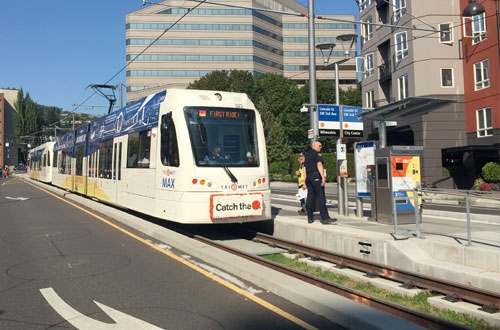TriMet opens MAX Orange Line
Written by Mischa Wanek-Libman, editor
State and federal officials along with project partners celebrated the opening of TriMet's MAX Orange Line on Sept. 12 with an Inaugural Ride as part of the daylong festivities.
“The Orange Line demonstrates smart transportation investments are critical to our economic growth,” said Oregon Gov. Kate Brown. “I am proud that state government could be a partner in this investment in our transportation future.”
TriMet said the project is its “most sustainable light-rail construction project.” The Orange Line features an eco-track, stormwater treatment, eco-roofs, rooftop solar panels, habitat restoration and regenerative energy storage.
According to TriMet, the project employed an industry-leading approach to sustainable design, piloted new technologies and leveraged infrastructure to incorporate sustainable practices, environmental improvements and human-scale design.
These improvements include 286 bioswales to capture and filter 1.8 million square feet of stormwater; $4 million in environmental mitigation funds; 16 solar installation sites; eight green roofs and the first vegetated trackway, eco-track, in the United States.
The use of eco-track is not the only “first” used on this line. TriMet contracted Siemens to install the first regenerative energy storage unit in the U.S. on the Orange Line. The technology allows for energy created during braking to be stored and then re-used in one of two forms, energy savings or voltage stabilization during peak demand times. TriMet will utilize the system in voltage stabilization mode, which will help avoid disruptions that can occur in mass transit operations if power drops below a certain level.
“Siemens is proud to be a technology partner for TriMet for more than 30 years, starting in the 1990s by providing our light rail vehicles to now operating a first-of-its kind regenerative energy storage system on TriMet’s new line,” said Kevin Riddett, president of Siemens Mobility. “This project is a perfect example of how advanced rail technologies can help bring transportation systems into the 21st century, revitalizing city centers, creating jobs and stimulating economic development while safeguarding the environment for future generations.”
The $1.49 billion Orange Line was delivered on time, as well as approximately $48 million under budget. The Federal Transit Administration (FTA) contributed $745.2 million for the extension through its Capital Investment Grant Program, covering half of the total project cost. The remaining cost was covered by state and local sources.
The 7.3-mile line extends from Portland State University, South Waterfront, across Tilikum Crossing to Southeast Portland, Milwaukie and north Clackamas County. The new line expands the MAX system to 60 miles and 97 stations.
“The MAX Orange Line will make a huge difference in the quality of life of thousands of people in the greater Portland area, offering a one-of-a-kind, world-class travel option between north Clackamas County and downtown Portland,” said FTA Acting Administrator Therese McMillan. “This project demonstrates the power of public transportation to help transform a major American city and bring 21st century transportation options to a growing population and future generations.”





